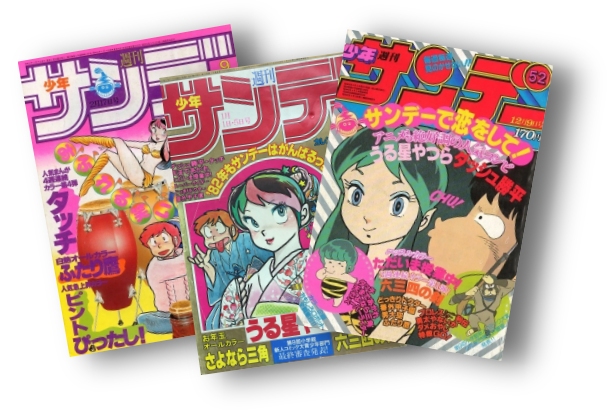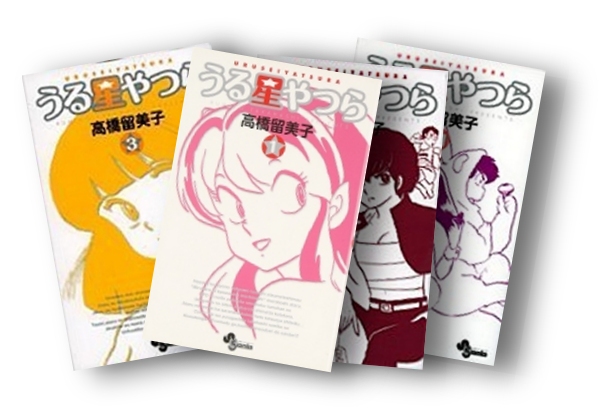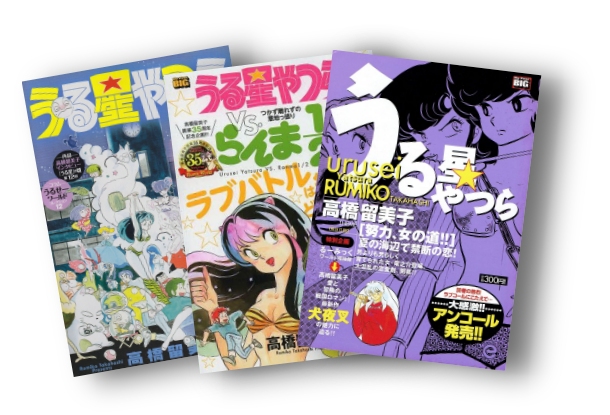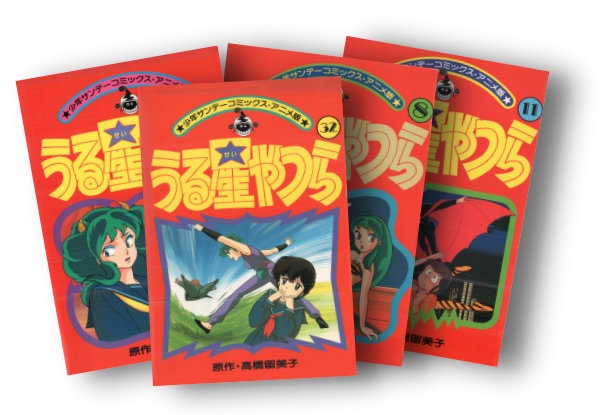
About the Manga
The runaway hit manga series Urusei Yatsura began in 1978. It became an instant critical and commercial success, earning a young Rumiko Takahashi the publishing giant Shogakukan's "Best New Artist Award." Still inexperienced at 21, Takahashi's run on Urusei Yatsura was produced sporadically for its first year. It was not until approaching 1980 that the comic finally kicked into high gear as a serialized weekly comic series in Shonen Sunday (one of the top two manga publications in the country at the time). There it reigned for most of the 1980s as one of the most widely read comic book series in the country until 1987 when Takahashi brought the manga to its conclusion.
| Weekly Serializations in Shonen Sunday (少年サンデー) |
 As mentioned, Urusei Yatsura was initially serialized in the large phonebook-sized weekly comic anthology Shonen Sunday. Every week a 16-page story would appear alongside more than 20 other titles. Occasionally Takahashi would get to do a few introductory color pages, or an entire duotone installment as a bonus to readers, but as with most manga, the comic was most often in black and white.
As mentioned, Urusei Yatsura was initially serialized in the large phonebook-sized weekly comic anthology Shonen Sunday. Every week a 16-page story would appear alongside more than 20 other titles. Occasionally Takahashi would get to do a few introductory color pages, or an entire duotone installment as a bonus to readers, but as with most manga, the comic was most often in black and white.
Some of the other notable manga series that were running in Shonen Sunday alongside Urusei Yatsura include Touch by Mitsuru Adachi, GuGu Ganmo by Fujihiko Hosono, To-Y by Atsushi Kamijo, Mai the Psychic Girl by Ryoichi Ikegami and Kazuya Kudo and Blazing Transfer Student by Kazuhiko Shimamoto. Shonen Sunday would remain Rumiko Takahashi's home for the rest of her career and after the conclusion of Urusei Yatsura in 1987 she would continue to publish all of her subsequence serials in Sunday. Finding the issues of Shonen Sunday where Urusei Yatsura originally appeared today can be challenging. Since such anthologies are made with newsprint quality paper and cost very little, they are not meant to last. Like a newspaper, they're traditionally read once, and then thrown away. Copies do still exist but they are rare given their age. |
| Tankobon (単行本) |
 Serializations of course were just the first step in Urusei Yatsura's legacy. As is the case with all successful manga series, as it was being produced, every few months the latest chapters of the series would be released as new book of collected stories. These novel-sized trade paperbacks called tankobon compiled the previous 11 weekly installments of the series in book form. The paper is of decent quality and the cover is surrounded in a plastic dust jacket with color art on it. By the end of the series in 1987, Urusei Yatsura had been collected into 34 tankobon volumes (nearly 6,000 pages of comics).
Serializations of course were just the first step in Urusei Yatsura's legacy. As is the case with all successful manga series, as it was being produced, every few months the latest chapters of the series would be released as new book of collected stories. These novel-sized trade paperbacks called tankobon compiled the previous 11 weekly installments of the series in book form. The paper is of decent quality and the cover is surrounded in a plastic dust jacket with color art on it. By the end of the series in 1987, Urusei Yatsura had been collected into 34 tankobon volumes (nearly 6,000 pages of comics).
Tankobon were the format Urusei Yatsura exclusively used for most of the 1980s. These days, Urusei Yatsura tankobon are still being sold at used bookstores, but they are no longer being reprinted. Tankobon for Urusei Yatsura are somewhat uncommon nowadays because of this, but can still be tracked down with a little effort. In the case of Urusei Yatsura this format has been replaced by the shinsobon (see below). In 2022 four box sets of newly reprinted editions of the tankobon were released to celebrate the 2022 anime adaptation of Urusei Yatsura which was made to celebrate the 100th anniversary of Takahashi's publisher, Shogakukan. The first three box sets contained 8 "poster cards" of color illustrations with the fourth set containing a brand new color illustration by Rumiko Takahashi. Shonen Sunday tankobon are all printed in the Japanese B6 format (12.8 cm × 18.2 cm or 5.04 in × 7.17 in). |
| Wideban (ワイド版) |
 Eventually the tankobon format was gradually phased out and the format of choice for Urusei Yatsura manga became the "wideban" (wide editions). These started being released one by one at the start of the 1990s around the 10th anniversary of the manga. These new special editions packed even more stories into each book with 25 chapters a piece. They featured beautiful new cover art and inserts as well as being printed on higher quality paper. The order of some of the stories are slightly rearranged, but otherwise you're getting the same stories that were collected within the tankobon. With 420 pages of comics at 680 yen (about $7.60 US) they are certainly far more economical. There are a total of 15 volumes due to having more chapters per volume than the original release.
Eventually the tankobon format was gradually phased out and the format of choice for Urusei Yatsura manga became the "wideban" (wide editions). These started being released one by one at the start of the 1990s around the 10th anniversary of the manga. These new special editions packed even more stories into each book with 25 chapters a piece. They featured beautiful new cover art and inserts as well as being printed on higher quality paper. The order of some of the stories are slightly rearranged, but otherwise you're getting the same stories that were collected within the tankobon. With 420 pages of comics at 680 yen (about $7.60 US) they are certainly far more economical. There are a total of 15 volumes due to having more chapters per volume than the original release.
|
| Bunkoban (文庫版) |
 Book companies always have this compulsion to continually release brand new editions of their old books. In doing so they hope to re-introduce it to a new audience. About 10 years after the wideban first appeared and took over the tankobon, these gave way to another edition called "bunkoban". This format is not as large as the wideban, but still much larger than the tankobon (bunkoban are A6 format, meaning they are 105 mm × 148 mm or 4.1 in × 5.8 in). One added bonus is that the books feature forewords by other prominent manga personalities talking about how Urusei Yatsura left an impression on them.
Book companies always have this compulsion to continually release brand new editions of their old books. In doing so they hope to re-introduce it to a new audience. About 10 years after the wideban first appeared and took over the tankobon, these gave way to another edition called "bunkoban". This format is not as large as the wideban, but still much larger than the tankobon (bunkoban are A6 format, meaning they are 105 mm × 148 mm or 4.1 in × 5.8 in). One added bonus is that the books feature forewords by other prominent manga personalities talking about how Urusei Yatsura left an impression on them.
|
| Shinsoban (新装版) |
 In 2007 Shogakukan decided to re-release the Urusei Yatsura as "shinsobon". These new editions are identical to the original 34 tankobon with new covers and a few bonuses for fans of the series. Like many other shinsobon re-releases each volume of Urusei Yatsura contains a "My Lumx34" section that features artwork by current manga artists who were inspired by Takahashi's first serial.
In 2007 Shogakukan decided to re-release the Urusei Yatsura as "shinsobon". These new editions are identical to the original 34 tankobon with new covers and a few bonuses for fans of the series. Like many other shinsobon re-releases each volume of Urusei Yatsura contains a "My Lumx34" section that features artwork by current manga artists who were inspired by Takahashi's first serial.
|
| My First Big |
 One format that is aimed at a different market are the "My First Big" editions. These are found primarily in convenience stores across Japan like Lawson, Family Mart and 7-11. They are manga compilations somewhat similar to tankobon, only they use cheaper materials on newsprint stock identical to the paper type Shonen Sunday is printed on. Because of this they are not as expensive as usual editions, although they are of lesser quality (and thus do not age as well). These books are not made for the collector who wants to keep manga for posterity. They are made for the casual reader who may be looking to pick up a quick read. They are rarely ever sold outside Japan so you're unlikely to come across them unless you live there.
One format that is aimed at a different market are the "My First Big" editions. These are found primarily in convenience stores across Japan like Lawson, Family Mart and 7-11. They are manga compilations somewhat similar to tankobon, only they use cheaper materials on newsprint stock identical to the paper type Shonen Sunday is printed on. Because of this they are not as expensive as usual editions, although they are of lesser quality (and thus do not age as well). These books are not made for the collector who wants to keep manga for posterity. They are made for the casual reader who may be looking to pick up a quick read. They are rarely ever sold outside Japan so you're unlikely to come across them unless you live there.
Despite their disposable quality they they occasionally had an interview with a mangaka about the series or some brief article about the series. As the covers shown here indicate there are a few different styles and formats that have been printed over the years. Some volumes even contain mixes of series like Urusei Yatsura and Ranma 1/2. |
| Art Books |
 Urusei Yatsura has had a number of artbooks focusing on both the manga and anime which goes to show the immense popularity of this series.
Urusei Yatsura has had a number of artbooks focusing on both the manga and anime which goes to show the immense popularity of this series.
The first artbook published in 1984 is the silver, hard-covered Tokimeki TV Memoir Urusei Yatsura Record Collection 1 (ときめきTVメモワール うる星やつら 記録全集1/Tokimeki TV Memowaaru Urusei Yatsura Kirokuzenshu 1), is a fantastic resource for the anime series filled with full color images and interviews. The book was labeled as "volume 1" indicating that more volumes were planned. Unfortunately no subsequent editions were ever published. A portfolio-style slip cover filled with illustrations, Urusei Yatsura - The Original Illustrations Selected by Rumiko Takahashi (うる星やつら 高橋留美子自選複製原画集/Urusei Yatsura Takahashi Rumiko Jisen Fukusei Gengashu), has 10 images inside, no text, and is a companion piece to the similarly designed Maison Ikkoku - Thoughts art collection. The next set are the exceedingly obscure Video Boy (動画少年/Doga Shonen) set of books. These are inexpensively made collections of images from the animators who worked on Urusei Yatsura and are much closer to a fanzine in terms of their style and presenation. The Video Boy masthead focused on other anime besides Urusei Yatsura though so far we have located three non-sequential issues that feature the series- issues 9, 11 and 12. Volume 15 is definitely not Urusei Yatsura related. Akemi Takada's artbook Pierrot Big Dissection (ぴえろ大解剖︎/Piero Dai Kaibo) celebrates the 40th anniversary of the legendary anime studio and showcases Akemi Takada's work on Urusei Yatsura, Creamy Mami and Kimagure Orange Road. The book features original artwork, character design sketches, interviews and episode summaries. While not technically an artbook, the two volume Urusei Yatsura Perfect Color Edition (うる星やつら パーフェクトカラーエディション) reproduces each chapter that contained color artwork from the series (both full color and red tinted pages). You can watch our video review of the books on our YouTube channel. A number of artbooks have also been released that feature all of Rumiko Takahashi's work and are not focused solely on one series. Of those: Rumiko Takahashi Exhibition - It's a Rumic World (高橋留美子展 It's a Rumic World/Takahashi Rumiko Ten It's a Rumic World) was published in 2007 and sold at the gallery exhibition of her work that ran in Japan from July 30th - August 11th of that year. It features color artwork from Urusei Yatsura, Maison Ikkoku, Ranma 1/2, Inuyasha, One-Pound Gospel, Mermaid Saga and a number of her short stories. One of the best overall overviews of Takahashi's career is Rumic World 35 which is a three volume boxset comprising All Star, Showtime and the collected children's manga MOON, The Great Pet King. The first two volumes mentioned contain character profiles, items, locations and color art for all of her series up to Kyokai no Rinne to celebrate 35th anniversary of her debut. |
| Anime Books (少年サンデーアニメ版 ) |
 Extremely popular manga series get turned into anime, and extremely popular anime get turn back into manga. The anime book series is 50 volumes long and takes still images from episodes of the television series and captions them with speech balloons like a traditional comic book. Takahashi's later series Inuyasha received a similar set of books while Ranma 1/2 had a single such publication.
Extremely popular manga series get turned into anime, and extremely popular anime get turn back into manga. The anime book series is 50 volumes long and takes still images from episodes of the television series and captions them with speech balloons like a traditional comic book. Takahashi's later series Inuyasha received a similar set of books while Ranma 1/2 had a single such publication.
|
| Miscellaneous Books |
 Some of the most insightful material written on Urusei Yatsura comes from the Shonen Sunday Graphic - Urusei Yatsura (少年サンデーグラフィック うる星やつら) collection of publications. These are 16 sturdy, magazine-style volumes with color artwork from both the anime and manga that was made specifically for these publications. Shonen Sunday Graphic - Urusei Yatsura has interviews about the films and manga, special short autobiographical manga from Rumiko Takahashi entitled The Diary of Kemo Kobiru, fan art and photographs of 1980s-era Urusei Yatsura collectibles. Decades later a new Urusei Yatsura book was released under the Shonen Sunday Graphic title for the 2022 anime entitled TV Anime Urusei Yatsura Official Starting Guide (TVアニメ『うる星やつら』公式スターティングガイド/TV Anime Urusei Yatsura Koushiki Sutaatingu Gaido).
Some of the most insightful material written on Urusei Yatsura comes from the Shonen Sunday Graphic - Urusei Yatsura (少年サンデーグラフィック うる星やつら) collection of publications. These are 16 sturdy, magazine-style volumes with color artwork from both the anime and manga that was made specifically for these publications. Shonen Sunday Graphic - Urusei Yatsura has interviews about the films and manga, special short autobiographical manga from Rumiko Takahashi entitled The Diary of Kemo Kobiru, fan art and photographs of 1980s-era Urusei Yatsura collectibles. Decades later a new Urusei Yatsura book was released under the Shonen Sunday Graphic title for the 2022 anime entitled TV Anime Urusei Yatsura Official Starting Guide (TVアニメ『うる星やつら』公式スターティングガイド/TV Anime Urusei Yatsura Koushiki Sutaatingu Gaido).
The spirit of the Shonen Sunday Graphics began in the Kitty Animation Circle newsletters. Over the years these transitioned from a fold-out poster called Urusei Yatsura Fanclub (うる星やつら ファンクラブ/Urusei Yatsura Fankurabu) in 1982 to a small pamphlet called Movement (ムーヴメント) that was published quarterly in 1986, going monthly in 1987 and was eventually rechistened We'll (ウィル) in 1993. The pamphlets featured information on a number of Kitty Animation Projects (but primarily focused on Urusei Yatsura, Maison Ikkoku and Ranma 1/2). Publication ceased in December 2000. Kitty Animation Circle would publish some one off magazine style pieces as well such as Urusei Yatsura/Maison Ikkoku Summer Carnival (うる星やつら めぞん一刻 夏カーニバル/Urusei Yatsura Maison Ikkoku Natsu Kaanibaru) and Gather With Anime from All Over the Country(全国のアニメと集まれ/Zenkoku no Anime to Atsumare). Another special book was made to celebrate the release of the Inaba the Dreammaker OVA entitled Urusei Yatsura You Can Meet Lum-chan in the New Film (うる星やつら 新作フィルムでラムちゃんに会えるぞ). Comic Jungle Exhibition (コミックジャングル展) is a portfolio featuring the work of 20 mangaka in 19 illustrations. Held on the 10th floor of Takashimaya Shinjuku building from August 6th to 18th, 1998, the exhibition and portfolio features the work of: Gosho Aoyama (Detective Conan), Fujio Akatsuka (Osomatsu-kun), Mitsuru Adachi (Touch), Shotaro Ishinomori (Sabu and Ichi's Detective Memoirs), Kazuo Umezu (Makoto-chan), Naoki Urasawa (YAWARA!), Kenichi Kitami & Juzo Yamazaki (Fishing Fool's Diary), Takao Saito (Golgo 13), Sanpei Shirato (Legend of Kamui), Rumiko Takahashi (Urusei Yatsura), Tetsuya Chiba (Notari Matsutaro), Osamu Tezuka (Hidamari no Ki), Moto Hagio (The Poe Clan), Norifumi Hirokane (Like Shooting Stars in the Twilight), Fujiko F. Fujio (Doraemon), Fujiko Fujio (A) (Aishiri someshi koro ni), Leiji Matsumoto (Cockpit Legend), Shinji Mizushima (Abu-san) and Akio Yoshida (BANANA FISH). The outer box is approximately 52.5cm x 37.0cm x 1.5cm. Three song books were published that featured sheet music for Urusei Yatsura one is Urusei Yatsura Piano Narration Sound Animation (うる星やつら ピアノ弾き語り●サウンドアニメ/Piano Kikigatari Soundo Anime) featured piano music and the other, Urusei Yatsura Song Book (うる星やつら ソング Book) was for guitar. The above mentioned Shonen Sunday Graphics also often featured sheet music for various theme songs from the anime series as well. A third book, 1985's Remember My Love (Piano Narration Sound Animation) (リメンバー・マイ・ラブ (サウンドアニメ・ピアノ弾き語り)/Remember My Love (Sound Anime Piano Kikigatari)) has more piano music including songs from later in the series than the first book mentioned here. Simply titled English Translation Urusei Yatsura (英訳 うる星やつら/Eiyaku Urusei Yatsura)this is a four volume collection of the series in English was released in 1983 and were used to help Japanese people study the English language in a fun way. As an artifact of manga-in-English, these were made when the series was still being released in Japan and predate almost any manga being translated into English (Urusei Yatsura or otherwise). The English translation was done by Bruce M. Wilkerson (ブルース・M.ウィルカースン). The Shonen Sunday Novels Urusei Yatsura is a set of five light novels (小説/shosetsu) which contains new cover and interior illustrations by Rumiko Takahashi. This novelization was written by Tomoko Konparu, who has also written novelizations of Takahashi's Inuyasha and Mermaid Saga. Additionally Konparu wrote the screenplays for Only You, Remember My Love and The Final Act films. A book examining the success of Shonen Sunday in 1983 entitled 1983 Youth of Romantic Comedies Shonen Sunday (1983年の「ラブコメ青春」サンデー/1983 nen no "Rabucome Seishun" Sandee) features a reprint of a chapter of Urusei Yatsura, an interview with Rumiko Takahashi and many other Sunday titles from 1983. Also included are interviews with Mitsuru Adachi, Gosho Aoyama, editor-in-chief Kazuyoshi Tanaka and an article by Kazushi Shimada. |
| Foreign Editions |
 Urusei Yatsura was published in North America by Viz, who are an American subsidiary of Japanese publisher Shogakukan (who own Shonen Sunday). When they were a small company, Viz obtained the rights for Urusei Yatsura and in 1989 gradually began releasing their own English translated version of the manga under the name Lum * Urusei Yatsura. They were released monthly as standard American-sized comic books, each with two chapters per issue. Since Urusei Yatsura was originally released in Japan at a rate of four stories per month, this meant American readers received it at half the speed of the original Japanese release.
Urusei Yatsura was published in North America by Viz, who are an American subsidiary of Japanese publisher Shogakukan (who own Shonen Sunday). When they were a small company, Viz obtained the rights for Urusei Yatsura and in 1989 gradually began releasing their own English translated version of the manga under the name Lum * Urusei Yatsura. They were released monthly as standard American-sized comic books, each with two chapters per issue. Since Urusei Yatsura was originally released in Japan at a rate of four stories per month, this meant American readers received it at half the speed of the original Japanese release.
Although the series gained a strong fanbase early on, the series was put on hiatus after it's initial run of 7 issues. It returned years later serialized in Viz' own Animerica magazine where it was well recieved enough to be brought back into its own monthly comic book. Because of their long hiatus in America the series was renamed The Return of Lum * Urusei Yatsura (not having anything to do with the storyline itself). After getting about 1/3 of the way through the manga, The Return of Lum went into another hiatus in 1998. Viz simply were not able to market the series properly and no longer put any effort into promoting it. It had trouble keeping its audience among their more modern action-oriented titles. Two decades passed before Viz decided to try once more. In 2019 Viz committed to releasing the entirety of the series. They published the story in large-format books with fresh translations to get throught he old material and get into the later chapters where Takahashi's art style had matured and looks more familiar to fans of Maison Ikkoku and Ranma 1/2. In 2023 this edition finally reached its conclusion, marking the first time that the entirety of Urusei Yatsura was officially published in English. Outside Japan, Urusei Yatsura has been translated into several languages other than just English such as Italian, Spanish, Cantonese and more. |